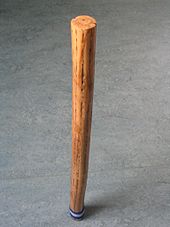Rainmaker
Rainmaker or rain stick (English rainmaker, rainstick , Spanish palo de lluvía ) is a tubular vessel rattle serving as an effect instrument , which is about 25 to 150 centimeters long and about 4 to 10 centimeters in diameter.
origin
The rainmaker originally comes from northern Chile . Its origin is the very dry Atacama area , where it was first built by the Diaguitas Indians in the Elquital and used for rain ceremonies .
Design
The rainmaker is made from the Copado cactus . Only dead cacti that are already lignified are used. The thorns are driven into the interior of the cactus. Then the rain maker is filled with small pebbles and closed at both ends.
Modern variants of the instrument are also made of bamboo or plastic and filled with rattle bodies made of different materials to achieve different sound effects.
The Regenmacher is one of the indirectly beaten idiophones . There is a certain similarity to the nail violin , a string idiophone in which there is a row of nails on the outside of the sound box, which are stroked with a bow.
Style of play
If you turn the rainmaker around, the small pebbles fall from one thorn to the next. This creates a pleasant, even sound that is reminiscent of flowing water or the rustling of thick raindrops. While in South America the medicine men wanted to lure the longed-for rain with the soft rustling sound of the rainmaker, one enjoys the pleasant sound with the calming effect.
The sound spectrum ranges from fine, delicate drizzle to the powerful rustling of a downpour. It "rains" more persistently, the longer the rainmaker is and the more spikes hold back the path of the pebbles. Short variants are also used as rhythm instruments that can be quickly shaken.
Audio sample:
Web links
- Homemade musical instruments. GEOlino (building instructions for children)
Individual evidence
- ↑ E. Heron-Allen, Hugh Davies: Nail violin. In: Laurence Libin (Ed.): The Grove Dictionary of Musical Instruments . Vol. 3, Oxford University Press, Oxford / New York 2014, pp. 566f

